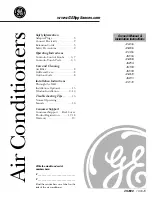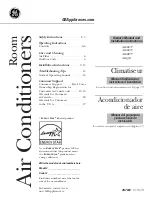
8
Flare cutting dimensions
Flare nut tightening torque
B
C
D
Die
Copper pipe
Fig. 5-6
A
A
B
Fig. 5-7
(Fig.
5-6)
Copper pipe O.D.
(mm)
Flare dimensions
øA dimensions (mm)
ø6.35
8.7 - 9.1
ø9.52
12.8 - 13.2
ø12.7
16.2 - 16.6
ø15.88
19.3 - 19.7
(Fig.
5-6)
Copper pipe O.D.
(mm)
Flare nut O.D.
(mm)
Tightening torque
(N·m)*
ø6.35
17
14 - 18
ø6.35
22
34 - 42
ø9.52
22
34 - 42
ø9.52
26
49 - 61
ø12.7
26
49 - 61
ø12.7
29
68 - 82
ø15.88
29
68 - 82
ø15.88
36
100 - 120
* 1 N·m 10 kgf·cm
5. Installing the refrigerant piping
5.5. Connecting pipes (Fig. 5-6)
• When commercially available copper pipes are used, wrap liquid and gas pipes
with commercially available insulation materials (heat-resistant to 100 °C or more,
thickness of 12 mm or more).
• The indoor parts of the drain pipe should be wrapped with polyethylene foam insula-
tion materials (specific gravity of 0.03, thickness of 9 mm or more).
• Apply thin layer of refrigerant oil to pipe and joint seating surface before tightening
flare nut.
• Use two wrenches to tighten piping connections.
• Use leak detector or soapy water to check for gas leaks after connections are
completed.
• Apply refrigerating machine oil over the entire flare seat surface.
• Use the flare nuts as follows.
N
Pipe size (Outdoor unit-Branch box)
Pipe size
(ømm)
Liquid
ø9.52
Gas
ø15.88
N
Pipe size (Branch box-Indoor unit) *Case of M series or S series Indoor unit
Indoor
unit type
(kW)
15
20
22
25
35
42
50
60
71
80
Pipe size
(ømm)
Liquid ø6.35
ø6.35
ø6.35
ø6.35
ø6.35
ø6.35
ø6.35
ø6.35
ø9.52
ø9.52
Gas
ø9.52
ø9.52
ø9.52
ø9.52
ø9.52
ø9.52
ø12.7 ø15.88 * ø15.88 ø15.88
* When using 60 type indoor unit of MEXZ series, use the flare nut in the
indoor unit accessory for the gas side connecting of indoor unit.
Do not use the flare nut (gas side) attached to the indoor unit. If it is used,
a gas leakage or even a pipe extraction may occur.
N
Pipe size (Branch box-Indoor unit) *Case of P series indoor unit
Indoor unit
type
(kW)
*1
35
*1
50
60
71
*2
100
Pipe size
(ømm)
Liquid
ø6.35
ø6.35
ø9.52
ø9.52
ø9.52
Gas
ø12.7
ø12.7
ø15.88
ø15.88
ø15.88
*1 When using 35, 50 type indoor unit of P series, use the flare nut attached
to the indoor unit.
Do not use the flare nut in the indoor unit accessory. If it is used, a gas
leakage or even a pipe extraction may occur.
*2 For details about connecting the pipes for the P100 indoor unit, refer to the
installation manual of the Y-shape connection pipe (PAC-AK52YP-E).
• When bending the pipes, be careful not to break them. Bend radii of 100 mm to 150
mm are sufficient.
• Make sure the pipes do not contact the compressor. Abnormal noise or vibration
may result.
Pipes must be connected starting from the indoor unit.
Flare nuts must be tightened with a torque wrench.
Flare the liquid pipes and gas pipes and apply a thin layer of refrigeration oil (Ap-
plied on site).
• When usual pipe sealing is used, refer to Table 2 for flaring of R410A refrigerant
pipes.
The size adjustment gauge can be used to confirm A measurements.
Caution:
• Be sure to wrap insulation around the piping. Direct contact with the bare
piping may result in burns or frostbite.
Table 2
(Fig. 5-7)
Copper pipe O.D.
(mm)
A (mm)
Flare tool for R410A
Flare tool for R22·R407C
Clutch type
ø6.35 (1/4”)
0 - 0.5
1.0 - 1.5
ø9.52 (3/8”)
0 - 0.5
1.0 - 1.5
ø12.7 (1/2”)
0 - 0.5
1.0 - 1.5
ø15.88 (5/8”)
0 - 0.5
1.0 - 1.5
The lineup of a connectable indoor unit
depends on a district/areas/country.
Refrigerant collection when relocating the indoor and outdoor units
(pump down)
Connect a gauge manifold valve (pressure gauge included) to the service port
near the gas stop valve of the outdoor unit so that the refrigerant pressure
can be measured.
Turn on the power supply (circuit breaker).
Close the liquid stop valve, and then perform the test run for cooling operation
(SW4-1: ON and SW4-2: OFF).
* Be sure to wait at least 3 minutes after turning on the power supply before
setting SW4-1 and SW4-2. If the DIP switches are set before 3 minutes has
elapsed, the test run may not start.
Fully close the gas stop valve when the pressure reading on the gauge drops
to 0.05 - 0.00 MPa* (approximately 0.5 - 0.0 kgf/cm
2
).
* If too much refrigerant has been added to the air conditioner system, the pres-
sure may not drop to 0.5 kgf/cm
2
. If this occurs, use a refrigerant collecting
device to collect all of the refrigerant in the system, and then recharge the
system with the correct amount of refrigerant after the indoor and outdoor
units have been relocated.
Stop the air conditioner operation (SW4-1: OFF and SW4-2: OFF).
Turn off the power supply (circuit breaker).
90° ± 0.5°
R0.4~R0.8
øA
452


































